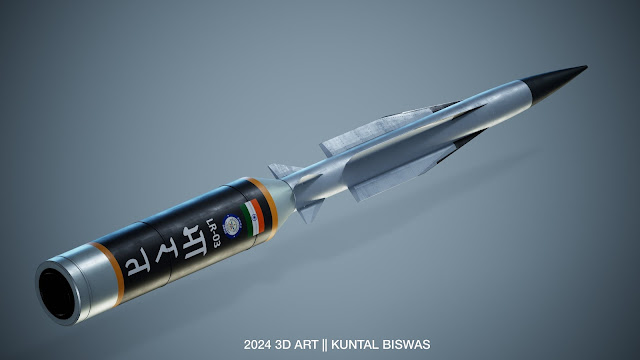On the 17th of November 2024, a test launch of the medium-ranged K-4 SLBM was conducted from the recently commissioned Indian nuclear ballistic missile submarine (SSBN) INS Arighaat. I had previously written about the commissioning of this boat which is also known as S3 or by its pennant number SSBN-81.
INS Arighaat is the second submarine in the Arihant-class, which comprises four SSBNs total - the first two (S2 Arihant & S3 Arighaat) with 4 x SLBM launch tubes and the last two (S4 & S4*, not yet named) with 8 x SLBM launch tubes.
It's being reported that this was the first test of the K-4 SLBM from an actual submarine (though some analysts in the know suspect this was just the first 'public' test from a submarine), all previous tests of the missile being from a submerged pontoon test platform.
With a stated range of 3,500 kilometers with a 1-ton (nuclear) payload, the K-4 serves a deterrence purpose by holding major Chinese targets like Beijing and Shanghai within its reach if employed from the northern portions of the Bay of Bengal.
Below is an older video of the missile from one of its previous pontoon-based tests.
However, having to launch from a very specific part of the water in order to reach those targets presents the Indian defence planners with a problem as those waters could be patrolled and/or monitored by Chinese PLA Navy SSNs, which are known to visit the Indian Ocean Region and India's periphery increasingly often. This is why India continues to pursue development of longer-ranged SLBMs like the K-5 and K-6, which supposedly have intercontinental ranges.
The K-5 may find application on the S4 and S4*, while the K-6 appears to be offering a definitive capability that would only equip the future S5-class SSBNs.
 |
| Artistic impression of the K4 SLBM; Sourced via overtdefense.com |
A nominal range of at least 6,000 kilometers while carrying a MIRVed payload is necessary in order to attain credible deterrence value against the People's Republic of China - and that definitive capability appears to be India's eventual goal with its SSBN & SLBM programs. But this might only be achieved at some point in the next decade (2030s).
But what the K-4 also symbolizes in the meantime is an ability to ensure a truly survivable deterrence against India's other nuclear-armed adversary, Pakistan. The K-4's increased range over the previous K-15 SLBM would mean that India's SSBNs operating in the Bay of Bengal would now be capable of rapidly carrying out launches against major Pakistani counter-value targets like the capital Islamabad and the largest city Karachi without having to spend a considerable amount of time (several days) travelling from the Bay of Bengal to the Arabian Sea in order to bring at least Karachi into range (Islamabad would have still been out of reach for the K-15).
++++
Another interesting development out of India is the test of a Hypersonic missile reportedly called the Long-Range Anti-Ship Missile or LRAShM (pronounced L-Rashem?) on 16 November 2024. The configuration of the weapon appears to be a Hypersonic Boost-Glide Vehicle (HBGV) sitting on top of a large solid rocket booster which is estimated to have the same diameter as the K-4 SLBM.
The only officially stated number about this weapon seems to be its range - a reported 1,500 kilometers - and the fact that it travels at hypersonic speeds (Mach 5 or above) throughout its flight envelop, which might include several maneuvers/altitude variations considering it has the flight control surfaces to affect such movement.
 |
| LRAShM during its maiden public test; the object on top is the 'lid' of the sealed canister from which it was launched, it remained stuck on the nose cone for a short while after the ejection |
No official figure is stated as to its maximum speed capability - with various analysts speculating it could be between Mach 6 and Mach 9. All that said, it could represent a capability similar to China's DF-17/DF-ZF which also employs a Hypersonic Glide Vehicle (HGV, not the same as a HBGV) payload employed over a similar range (1,600 km).
If deployed in ground-based launchers in the Andaman & Nicobar Islands, the LRAShM can pose a significant threat (over and above what the extended-range BrahMos already represents) to any Chinese PLAN surface task force and/or Carrier Battle Group attempting to traverse the Malacca Strait.
 |
| 3D Model of the LRAShM by artist Kuntal Biswas, sourced via Twitter; the nose cone & the leading edges of the 'control fins' appear to be coated in a material that's tolerant of extremely high temperatures expected in hypersonic flight |
If the Arihant-class ends up being relegated to a comparatively less demanding conventionally-armed SSGN role following the commissioning of the S5-class in the nuclear deterrence role, the LRAShM might also end up being carried by the Arihant-class boats. Just 4 to 8 of these weapons (considering they have a booster that is the same size as K-4's first stage) with conventional payloads wouldn't cause much damage to a land-based target, but can be potentially devastating in a long-range anti-ship/carrier-killing role.
The smaller upper stage (the HBGV itself), with an estimated diameter of 0.6m, might also be carried independently (without the booster, or with a smaller booster of the same diameter as the upper stage) for greater magazine depth (12 to 24 missiles, triple-packed in the silos just like the 0.74m diameter K-15 SLBMs) but with an understandably shorter range of perhaps around 500 to 700 kilometers.
Interesting things to look forward to.


.jpg)











